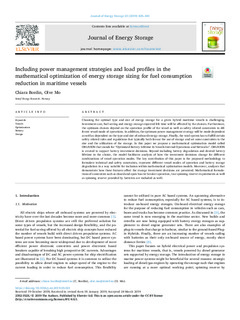| dc.contributor.author | Bordin, Chiara | |
| dc.contributor.author | Mo, Olve | |
| dc.date.accessioned | 2019-06-18T12:30:55Z | |
| dc.date.available | 2019-06-18T12:30:55Z | |
| dc.date.created | 2019-04-23T09:23:39Z | |
| dc.date.issued | 2019 | |
| dc.identifier.citation | Journal of Energy Storage. 2019, 23 425-441. | nb_NO |
| dc.identifier.issn | 2352-152X | |
| dc.identifier.uri | http://hdl.handle.net/11250/2601212 | |
| dc.description.abstract | Choosing the optimal type and size of energy storage for a given hybrid maritime vessels is challenging. Investment cost, fuel saving and energy storage expected life time will be affected by the choices. Furthermore, the optimum choices depend on the operation profile of the vessel as well as safety related constraints in different vessel mode of operations. In addition, the optimum power management strategy will be mode dependent as well as dependent on the type and size of onboard energy storage. Finally, the total system has to fulfill certain safety related rules and regulations that typically both favour the use of storage and set some constraints to the size and the utilization of the storage. In this paper we propose a mathematical optimisation model called OBLIVION that stands for “Optimised Battery Lifetime In Vessels Internal Operations and Networks”. OBLIVION is created to support battery investment decisions. Beyond including battery degradation and desired battery lifetime in the choice, the model facilitates analysis of how the investment decisions change for different combinations of vessel operation modes. The key contribution of this paper is the proposed methodology to formulate technical and safety constraints, represent different vessel modes of operation and battery storage degradation in a way suitable for inclusion within mathematical optimisation models. Moreover, analyses that demonstrate how these features affect the storage investment decisions are presented. Mathematical formulations of constraints such as closed and open bus-tie breaker operation, true spinning reserve requirements as well as spinning reserve provided by batteries are included as well. | nb_NO |
| dc.description.abstract | Including Power Management Strategies and Load Profiles in the Mathematical Optimization of Energy Storage Sizing for Fuel Consumption Reduction in Maritime Vessels | nb_NO |
| dc.language.iso | eng | nb_NO |
| dc.publisher | Elsevier | nb_NO |
| dc.rights | Navngivelse 4.0 Internasjonal | * |
| dc.rights.uri | http://creativecommons.org/licenses/by/4.0/deed.no | * |
| dc.subject | Vessels; | nb_NO |
| dc.subject | Optimisation | nb_NO |
| dc.subject | Battery | nb_NO |
| dc.subject | Design | nb_NO |
| dc.title | Including Power Management Strategies and Load Profiles in the Mathematical Optimization of Energy Storage Sizing for Fuel Consumption Reduction in Maritime Vessels | nb_NO |
| dc.type | Journal article | nb_NO |
| dc.type | Peer reviewed | nb_NO |
| dc.description.version | publishedVersion | nb_NO |
| dc.rights.holder | The Authors | nb_NO |
| dc.source.pagenumber | 425-441 | nb_NO |
| dc.source.volume | 23 | nb_NO |
| dc.source.journal | Journal of Energy Storage | nb_NO |
| dc.identifier.doi | https://doi.org/10.1016/j.est.2019.03.021 | |
| dc.identifier.cristin | 1693355 | |
| cristin.unitcode | 7548,50,0,0 | |
| cristin.unitcode | 7548,0,0,0 | |
| cristin.unitname | Energisystemer | |
| cristin.unitname | SINTEF Energi AS | |
| cristin.ispublished | true | |
| cristin.fulltext | original | |
| cristin.qualitycode | 1 | |

